- Traders price interest rates reaching 4%
- Oil returns to near-2008 levels
- US dollar slips
Key Events
On Tuesday, futures on the Dow Jones, S&P 500, NASDAQ 100, and Russell 2000 were slightly higher after a four-day selloff, exacerbated by higher than expected US inflation figures on Friday which sparked stronger recession fears. European stocks also opened higher this morning but then slipped into negative territory.
Ahead of an interest rate announcement from the US Federal Reserve on Wednesday, traders are continuing to move out of longer-dated US Treasuries, sending yields higher. Some are now expecting that the Fed will have to hike rates to a point that brings them closer to 4% in order to tame rising prices.
Global Financial Affairs
All four US futures were green on Tuesday, with contracts on the tech-heavy NASDAQ 100 outperforming. The technology sector benchmark taking the lead on both green and red days continues as investors flip-flop from growth to value stocks on lingering inflation concerns.
In Europe, the STOXX 600 Index initially rebounded along with US futures, but is now lower, down over 1%. Concerns that there may be further disruptions to trade in the Eurozone after Britain published legislation on Monday to tackle ongoing issues regarding post-Brexit trade with Northern Ireland dented sentiment.
The UK Prime Minister, Boris Johnson wants to unilaterally change the Northern Ireland protocol, inked as part of Britain's Brexit divorce deal with the EU. The pan-European index has sold off almost 7% for the last four consecutive days.
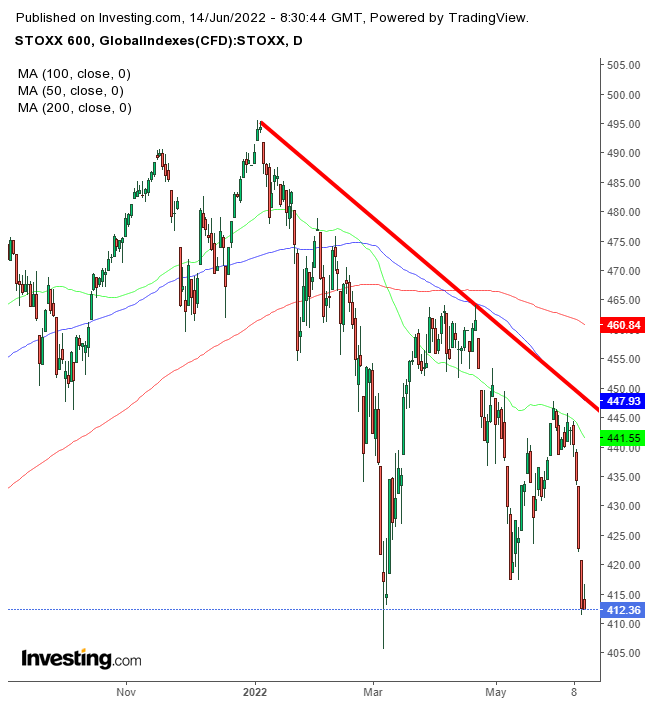
Today's candle may produce an Inverted Hammer, bullish upon the next candle's close finishing above today's candle's natural body. The European benchmark reached the lowest level since March 2021 on a closing basis. If the price registers below the low of March this year, it will extend the downtrend.
Financials and the oil & gas sector led the gainers, with the latter maintaining the sector's uptrend.
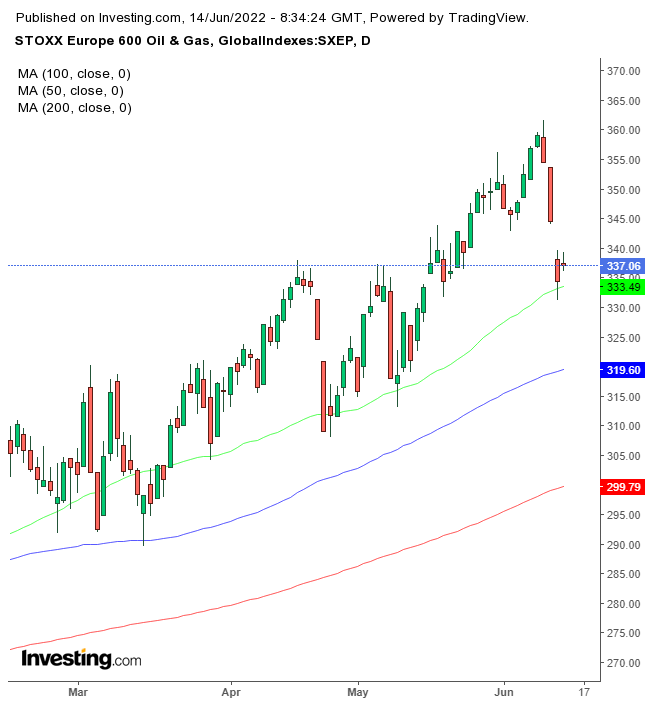
After dipping below and closing above its 50 DMA yesterday, the STOXX Europe 600 Oil & Gas Index opened higher today but then slumped.
Conversely, the STOXX Europe 600 Real Estate Index underperformed, falling to its lowest since May 2020, extending its downtrend.
Earlier, most Asian shares fell sharply after Monday's carnage on Wall Street which resulted in the S&P 500 moving into a bear market
The MSCI All Country Asia Pacific ex-Japan dropped about 0.5%, extending a decline to its fourth day for a 5.5% cumulative loss.
Australian shares suffered a steep selloff, as the ASX 200 closed over 3.5% lower, clawing back an intraday 5% selloff, erasing briefly almost AUD$90 billion. The market down under took the brunt of the regional selloff as it was closed on Monday. As such, local investors had to play catch up to the US inflation data published on Friday.
Chinese stocks were the only regional equity markets trading in the green this morning. While Hong Kong's Hang Seng eked out a marginal gain, China's Shanghai Composite advanced 1.02%. China's gauge also initially fell but managed to bounce and close near the session's high which was also its highest level since Mar. 11.
The wild advance in bond yields continues to warn of further stock market selloffs. The 3% level for the 10-year Treasury yield seems to be critical, as at that level equities tend to take a hit, something we saw in early May and late 2018 (worst Christmas eve ever).
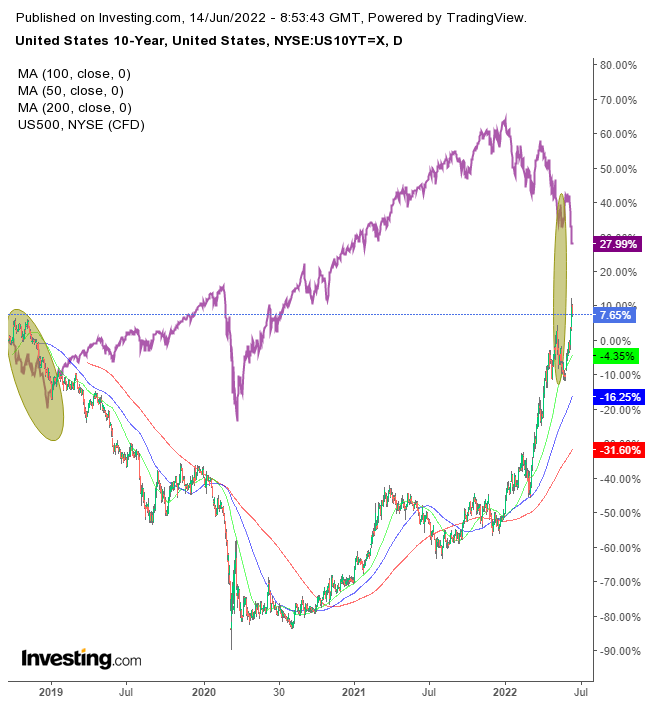
Although yields eased and dipped below 3.4% they remain well above the key 3% key level mentioned.
The dollar retreated but may have already completed a significant bullish pattern.
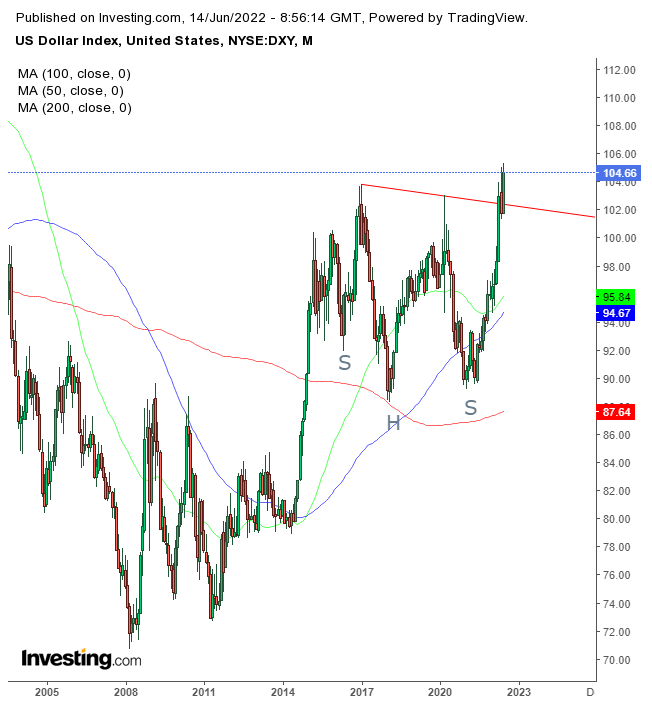
The greenback may have completed an H&S Continuation pattern, which may have started to develop in 2016. If the pattern follows through on its presumed dynamics, we can see the dollar reaching 116.
Gold dropped for the second day, falling below its 200 DMA and toward its rising trendline.

The 50 DMA crossed below the 100 DMA as more recent pricing weakens.
Bitcoin rebounded from a 7% drop but remains slightly lower. Yesterday, the cryptocurrency plunged 15.5%, extending a sell-off to its seventh day in a row, completing a Continuation Pattern as well as finally completing our long-waited massive double top. All of which signal a continued slide toward single-digit thousands.
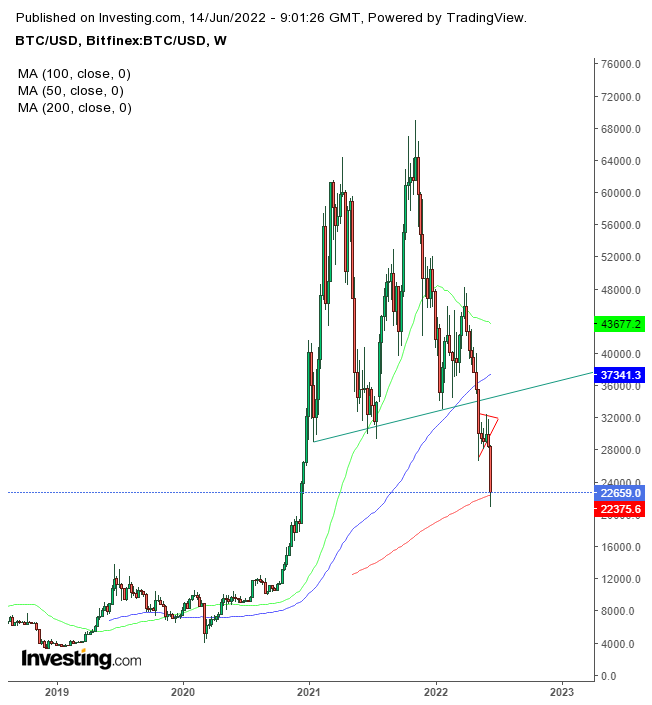
The price found demand by the 200 WMA, its last support before 12,000—the 2019-2020 high—where we expect the digital token to eventually land.
Oil climbed for the second day, back toward $122, its highest since 2008.
Up Ahead
- US retail sales figures are published on Wednesday.
- On Wednesday US crude oil inventories are printed.
- ECB President Christine Lagarde is due to speak Wednesday.
Market Moves
Stocks
- The MSCI Asia Pacific Index fell 0.9%.
Currencies
- The euro rose 0.2% to $1.0428
- The Japanese yen rose 0.15% to 134.2 per dollar
- The offshore yuan fell 0.4% to 6.755 per dollar
- The British pound fell 0.3% to $1.2101
Bonds
Commodities
- Brent crude rose 0.7% to $123.10 a barrel
- Spot gold rose 0.1% to $1,820.66 an ounce
